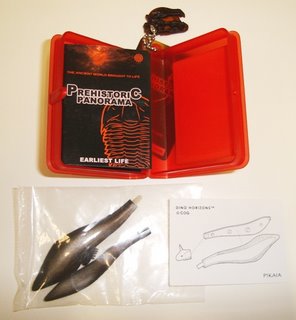 Wow, would you believe it, in just two months Fresh Brainz has already hit 101 posts! Yes, it has been a pleasure writing for you, my friends!
Wow, would you believe it, in just two months Fresh Brainz has already hit 101 posts! Yes, it has been a pleasure writing for you, my friends!*bows*
And in this celebratory mood today, I will blog about something light.
Like toys!
I just bought this toy recently.

It was sitting together with a bunch other education toys such as plastic dinosaur kits at a Popular Bookstore.
Of course I like dinosaurs too, but I bought this because I don't have a plastic model of a Cambrian animal yet. There is small selection of these.
I chose the Pikaia. I'll tell you why later, it's a nice story.
This is actually a small, pocket-sized toy that is really cheap, about four dollars. I like the way they make the packaging look like a book (not terribly original though).

Inside is a tiny booklet (written very simply for kids), the unassembled plastic model and an instruction sheet.
Just three pieces. It isn't brain surgery.

Viola! All assembled. It took like two seconds.
So now that I am the proud new owner of a Pikaia toy, you might be wondering - what's so special about it?
Actually there is nothing really special about Pikaia. It's just a small, extinct animal that lived in the ocean over 500 million years ago.
It wasn't the biggest, it wasn't the fastest, it wasn't the strongest and it certainly wasn't the most exotic-looking animal of its time.
Compare it to the ferocious Anomalocaries. Ten times larger, with fearsome grapper arms and a huge disc-shaped mouth - a killing machine!
It's certainly true that Pikaia was a middling, boring nobody. But an important nobody nonetheless, because Pikaia (or its cousin species) is the ancestor of all living chordates today.
That includes vertebrates like you and me.
In contrast, many exotic Cambrian animals like the Anomalocaries have no modern descendants.
You think, "Hey! Didn't Darwin say that evolution was about 'survival of the fittest'? What the fuck is so fit about a tiny grey fish-thingy?"
Actually Darwin never said that - he knew that the hottest hunk cannot contribute to the future biologically if he makes no babies. Herbert Spencer was the one who coined the term "survival of the fittest".
Perhaps Pikaia was only super good at baby-making. We may never know.
Still, what I want to say is: don't be discouraged if you feel yourself below par in terms of your looks, your abilities or your wealth. What is more important is how well you adapt to your environment.
We human beings are lucky that we are mobile enough to move to another environment when the going gets tough. In a supportive environment, every ordinary person has a good chance to live a happy life.
To learn more about Cambrian animals, here is a good interactive website from UC Berkeley.
Cheers!
 Creative people at Harvard have produced
Creative people at Harvard have produced  We at Fresh Brainz have never really understood the human attraction to the macabre. But yet I can't say that I disapprove of it, I wonder why...
We at Fresh Brainz have never really understood the human attraction to the macabre. But yet I can't say that I disapprove of it, I wonder why... No, this is not about the
No, this is not about the  Just came across this great new program from the Canadian Broadcasting Corporation (CBC) called
Just came across this great new program from the Canadian Broadcasting Corporation (CBC) called  The network in our institute has become so slow recently, it's utterly ridiculous. When searching online databases the screen would sometimes turn blank for several minutes. Pages can take minutes to load or fail to complete loading.
The network in our institute has become so slow recently, it's utterly ridiculous. When searching online databases the screen would sometimes turn blank for several minutes. Pages can take minutes to load or fail to complete loading.



 The Cassini spacecraft has discovered a new faint, wispy ring around Saturn.
The Cassini spacecraft has discovered a new faint, wispy ring around Saturn.



 Guess what's growing out of people's computers nowadays?
Guess what's growing out of people's computers nowadays?

